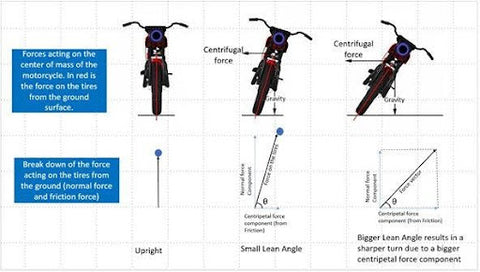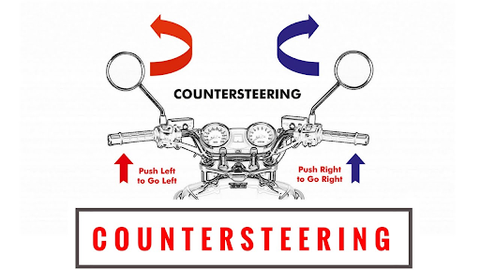Most of the time, the conversation between the rider is all about the riding style, the engine oil, and the techniques of cutting drifting. When you discuss these things, the most important term that comes to mind is how to handle a bike at high speed and control it during sharp turns and emergencies. These all can be done with better countersteering techniques. Riding a bike offers freedom and excitement like no other mode of transportation.
However, with great freedom comes with great responsibility and care, especially when mastering this technique.
This essential skill allows riders to handle their bike with precision and control, making it a fundamental aspect of safe and efficient riding.
In a current blog post, we will learn about motorcycle countersteering techniques, exploring their importance, bike mechanics, and how to execute them for better control on the road effectively.
So, whether riding the open road or wandering through tight turns, let's look at how to master this and enhance your riding skills to the next level.
The Physics of Countersteering
The Physics of steering amazes you with the fascinating mechanics that govern one of the most fundamental skills in motorcycle riding. It is the technique whereby a rider initiates a turn by momentarily steering the front wheel in the opposite direction of the intended lean. While it may seem counterintuitive, understanding the underlying physics sheds light on its effectiveness.
- At the heart of steering lies the principle of gyroscopic precession.
- When a motorcycle is in motion, the rotating wheels create gyroscopic forces that resist orientation changes.
- When the rider applies a brief steering input in the opposite direction of the desired turn, the gyroscopic forces cause the motorcycle to lean in the intended direction.
- This lean initiates the turn, allowing the rider to navigate corners with precision and control.
Moreover, the concept of lean angles plays an essential role in it. As the motorcycle leans into a turn, the contact patch of the tires shifts, altering the forces acting on the bike. By counting the motorcycle, the rider effectively reduces the radius of the turn, allowing for smoother and more efficient cornering.
In essence, this harnesses the principles of gyroscopic precession and lean angles to enable riders to maneuver their motorcycles with ease and precision. Mastery of this technique enhances cornering ability and contributes to overall riding confidence and safety on the road.

Basic motorcycle counter steering technique
Mastering the basic motorcycle counter steering technique is essential for precise and controlled cornering.
Here's a step-by-step guide on how to countersteer effectively, including the push-left-to-go-left and push-right-to-go-right principles:
Approach the Turn:
- As you approach the turn, maintain a relaxed and upright riding position, with your hands gripping the handlebars lightly.
- Determine the direction in which you need to turn your motorcycle to navigate the corner safely
Applying:
- If you want to turn left, gently push forward on the left handlebar with your left hand. This action may feel like you're pushing the handlebar away from you or toward the right.
- Conversely, if you want to turn right, apply pressure to the right handlebar by pushing forward with your right hand.
Lean into the Turn:
- As you apply this pressure, you'll notice your motorcycle begins to lean in the direction of the turn. Allow the bike to lean naturally while maintaining a relaxed posture.
- The degree of lean will depend on factors such as speed, road conditions, and the sharpness of the turn.
Maintain Control:
- Once the motorcycle is leaned into the turn, continue to look ahead and maintain a steady throttle position to control your speed through the corner.
- Avoid making sudden or jerky movements with the handlebars, as this can disrupt the stability of the motorcycle.
Exit the Turn:
- As you reach the apex of the turn and begin to straighten the motorcycle, gradually release this pressure and return the handlebars to their neutral position.
- Maintain a smooth and controlled exit from the turn, adjusting your speed and position as necessary to align with the direction of travel.
By following these steps and understanding the push-left-to-go-left and push-right-to-go-right principles, you can enhance your cornering skills and maneuver your motorcycle with precision and control. Remember always to prioritize safety and practice defensive riding habits while on the road.

Advanced Countersteering Tips
Mastering this at higher speeds requires finesse and confidence, as well as an understanding of advanced techniques to manage corners smoothly and safely.
In 2010, American driver Josh Brookes crashed during a Supersport race due to a motorcycle counter steering technique. Brookes tried it at the fast "Ballagarey Corner" part of the race. He accidentally used too much force, forcing his motorbike to deviate off the track and crash at high speed. Brookes was unharmed, but the event showed the need for precision, particularly in high-speed racing, when split-second choices may have devastating implications.
Here are some tips for advancing your skills, with advice from experienced riders and instructors:
Anticipate the Turn:
- Look ahead and anticipate upcoming corners early to give yourself ample time to prepare and adjust your speed and position accordingly.
- Use visual cues such as road signs, markings, and the curvature of the road to gauge the severity of the turn and plan your approach.
Relax Your Grip:
- Keep a calm grip on the handlebars and avoid tensing up, especially when navigating high-speed corners.
- Light, fluid inputs are key to maintaining control and stability, so focus on keeping your upper body loose and flexible.
Smooth Steering Inputs:
- Apply these inputs smoothly and progressively, rather than making abrupt or jerky movements with the handlebars.
- Gradually increase pressure on the handlebars to initiate the lean and maintain a steady, consistent input throughout the corner.
Trust the Lean:
- Trust the physics of this and allow the motorcycle to lean naturally into the turn.
- Avoid the temptation to fight against the lean or make corrective steering adjustments once the turn has been initiated, as this can destabilize the bike.
Use Body Positioning:
- Experiment with body positioning to enhance your control and stability through high-speed corners.
- Move your weight slightly towards the inside of the turn, keeping your torso upright and your head and eyes looking through the corner.
By adopting these advanced tips into your practice, you can maintain the confidence and ability needed to conquer high-speed corners with precision and control.

Common Countersteering Mistakes
To avoid these common Countersteering mistakes when learning to countersteer, focus on proper technique, practice regularly, and seek guidance from experienced riders or professional instructors.
Common mistakes among riders learning the technique include:
Oversteering:
Applying too much force on the handlebars can cause the motorcycle to lean excessively, leading to instability and potential loss of control. To avoid this, practice applying gradual and precise pressure on the handlebars when initiating a turn.
Delayed Response:
Some riders input may hesitate or delay their steering input, especially in emergencies. To overcome this, practice reacting Push steering quickly and decisively to changes in road conditions or traffic situations, anticipating the need for this.
Inadequate Body Positioning:
Improper body positioning can hinder effective steering and compromise stability during turns. Maintain a relaxed and upright posture while gripping the tank with your knees, allowing for smooth and controlled steering inputs.
Focusing on the Wrong Point:
Riders may fixate on obstacles or hazards instead of looking through the turn, leading to target fixation and potential collisions. Keep your eyes focused on the desired path of travel and look ahead to anticipate upcoming turns and traffic conditions.
Enrolling in a motorcycle training course can provide valuable instruction and feedback to help improve your skills and overall riding proficiency.
Role of Countersteering in Rider Safety
Proper counters play a crucial role in rider safety, particularly on highways and in curves, by enhancing control, stability, and maneuverability. Here's how:
Initiating Turns Safely:
This allows riders to initiate turns more effectively, especially at higher speeds. By pushing the handlebars in the direction opposite to the intended turn, riders can lean the motorcycle into the corner smoothly and efficiently, reducing the risk of understeering or oversteering.
Maintaining Stability:
When navigating curves or negotiating obstacles on the road, proper steering helps maintain stability by ensuring the motorcycle remains balanced throughout the maneuver. By leaning the motorcycle into the turn using counters, riders can distribute weight evenly and minimize the danger of skidding or loss of traction.
The rider may push left to go left or right to go right, improving stability when you decide in advance.
Avoiding Obstacles:
In emergencies, such as encountering debris or sudden obstacles on the road, quick and precise inputs can help riders maneuver around hazards safely. By leaning the motorcycle away from the obstacle using these counters, riders can create space to avoid collision and maintain control of the bike.
Proper steering is a fundamental skill that significantly contributes to rider safety on highways and in curves by facilitating smooth, stable, and controlled maneuvers.
Conclusion
Remember always to prioritize safety and continue to improve your skills through consistent practice and seeking guidance from experienced riders. And for those seeking a deeper understanding of motorcycle control, there are plenty of resources available, from instructional videos to advanced riding courses.
With dedication and determination, you can become a master of countersteering and elevate your riding abilities to the next level. Ride safe, and keep practicing!
FAQ
What is an example of countersteering?
Countersteering is a technique used in motorcycling where the rider gently counter-turns the handlebars in the opposite direction to which the front wheel is pointing. This helps to stabilize the motorcycle and maintain control when turning.
At what speed does countersteering work?
Countersteering is an essential technique used by motorcyclists to initiate turns at higher speeds. It's not about going fast per se but more about the physics of balancing a bike. Typically, countersteering kicks in around 10 to 15 miles per hour (16 to 24 kilometers per hour) and becomes more pronounced as speeds increase. It's like a subtle dance between the rider and the bike,
How do you know when to counter steer?
Counter steering is a split-second reaction when your vehicle starts veering off course, usually in response to a sharp turn or obstacle. You gently turn the steering wheel in the opposite direction to regain control. It's like a quick dance move to keep your car on track. With practice, it becomes second nature.











